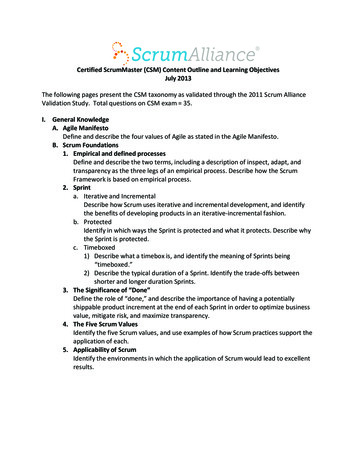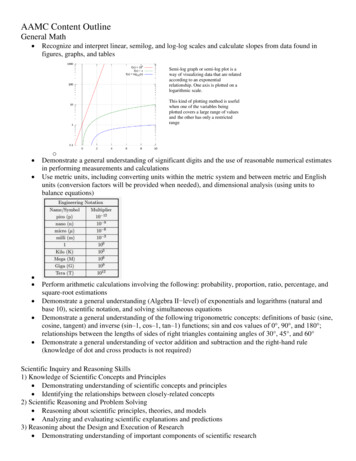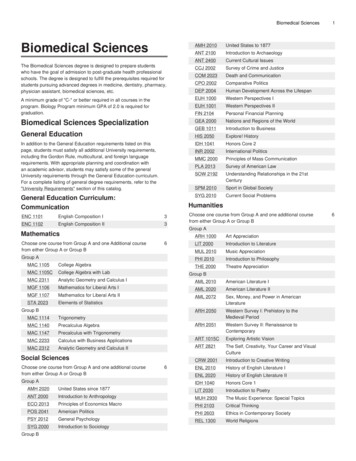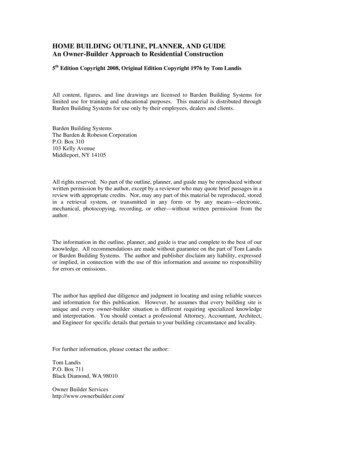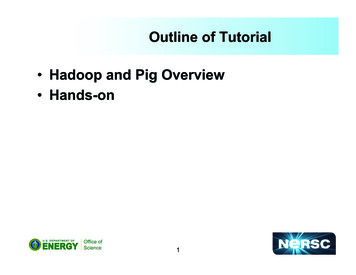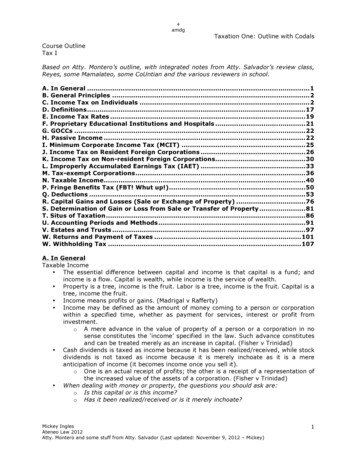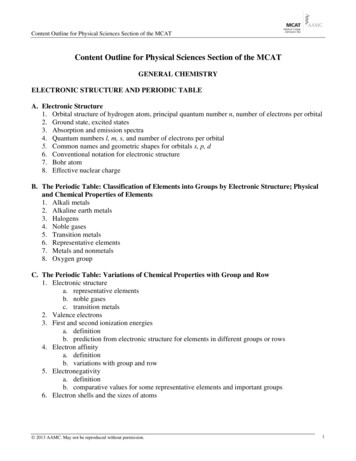
Transcription
Content Outline for Physical Sciences Section of the MCATContent Outline for Physical Sciences Section of the MCATGENERAL CHEMISTRYELECTRONIC STRUCTURE AND PERIODIC TABLEA. Electronic Structure1. Orbital structure of hydrogen atom, principal quantum number n, number of electrons per orbital2. Ground state, excited states3. Absorption and emission spectra4. Quantum numbers l, m, s, and number of electrons per orbital5. Common names and geometric shapes for orbitals s, p, d6. Conventional notation for electronic structure7. Bohr atom8. Effective nuclear chargeB. The Periodic Table: Classification of Elements into Groups by Electronic Structure; Physicaland Chemical Properties of Elements1. Alkali metals2. Alkaline earth metals3. Halogens4. Noble gases5. Transition metals6. Representative elements7. Metals and nonmetals8. Oxygen groupC. The Periodic Table: Variations of Chemical Properties with Group and Row1. Electronic structurea. representative elementsb. noble gasesc. transition metals2. Valence electrons3. First and second ionization energiesa. definitionb. prediction from electronic structure for elements in different groups or rows4. Electron affinitya. definitionb. variations with group and row5. Electronegativitya. definitionb. comparative values for some representative elements and important groups6. Electron shells and the sizes of atoms 2013 AAMC. May not be reproduced without permission.1
Content Outline for Physical Sciences Section of the MCATBONDINGA. The Ionic Bond (Electrostatic Forces Between Ions)1. Electrostatic energy q1q2/r2. Electrostatic energy lattice energy3. Electrostatic force q1q2/r2B. The Covalent Bond1. Sigma and pi bondsa. hybrid orbitals (sp3, sp2, sp, and respective geometries)b. valence shell electron-pair repulsion (VSEPR) theory, predictions of shapes of molecules(e.g., NH3, H2O, CO2)2. Lewis electron dot formulasa. resonance structuresb. formal chargec. Lewis acids and bases3. Partial ionic charactera. role of electronegativity in determining charge distributionb. dipole momentPHASES AND PHASE EQUILIBRIAA. Gas Phase1. Absolute temperature, K2. Pressure, simple mercury barometer3. Molar volume at 0 C and 1 atm 22.4 L/mol4. Ideal gasa. definitionb. ideal gas law (PV nRT)i. Boyle’s lawii. Charles’s lawiii. Avogadro’s law5. Kinetic theory of gases6. Deviation of real-gas behavior from ideal gas lawa. qualitativeb. quantitative (van der Waals equation)7. Partial pressure, mole fraction8. Dalton’s law relating partial pressure to compositionB. Intermolecular Forces1. Hydrogen bonding2. Dipole interactions3. London dispersion forces 2013 AAMC. May not be reproduced without permission.2
Content Outline for Physical Sciences Section of the MCATC. Phase Equilibria1. Phase changes, phase diagrams2. Freezing point, melting point, boiling point, condensation point3. Molality4. Colligative propertiesc. vapor pressure lowering (Raoult’s law)d. boiling point elevation (ΔTb Kbm)e. freezing point depression (ΔTf Kfm)f. osmotic pressure5. Colloids6. Henry’s lawSTOICHIOMETRY1.2.3.4.5.6.7.Molecular weightEmpirical formula versus molecular formulaMetric units commonly used in the context of chemistryDescription of composition by percent massMole concept, Avogadro’s numberDefinition of densityOxidation numbera. common oxidizing and reducing agentsb. disproportionation reactionsc. redox titration8. Description of reactions by chemical equationsa. conventions for writing chemical equationsb. balancing equations including redox equationsc. limiting reactantsd. theoretical yieldsTHERMODYNAMICS AND THERMOCHEMISTRYA. Energy Changes in Chemical Reactions: Thermochemistry1. Thermodynamic system, state function2. Endothermic and exothermic reactionsa. enthalpy H, standard heats of reaction and formationb. Hess’s law of heat summation3. Bond dissociation energy as related to heats of formation4. Measurement of heat changes (calorimetry), heat capacity, specific heat capacity (specific heatcapacity of water 4.184 J/g·K)5. Entropy as a measure of “disorder,” relative entropy for gas, liquid, and crystal states6. Free energy G7. Spontaneous reactions and ΔGº 2013 AAMC. May not be reproduced without permission.3
Content Outline for Physical Sciences Section of the MCATB. Thermodynamics1. Zeroth law (concept of temperature)2. First law (ΔE q w, conservation of energy)3. Equivalence of mechanical, chemical, electrical, and thermal energy units4. Second law (concept of entropy)5. Temperature scales, conversions6. Heat transfer (conduction, convection, radiation)7. Heat of fusion, heat of vaporization8. PV diagram (work done area under or enclosed by curve)RATE PROCESSES IN CHEMICAL REACTIONS: KINETICS AND EQUILIBRIUM1. Reaction rates2. Rate law, dependence of reaction rate on concentrations of reactantsa. rate constantb. reaction order3. Rate-determining step4. Dependence of reaction rate on temperaturea. activation energyi. activated complex or transition stateii. interpretation of energy profiles showing energies of reactants and products,activation energy, ΔH for the reactionb. Arrhenius equation5. Kinetic control versus thermodynamic control of a reaction6. Catalysts, enzyme catalysis7. Equilibrium in reversible chemical reactionsa. law of mass actionb. the equilibrium constantc. application of Le Châtelier’s principle8. Relationship of the equilibrium constant and ΔGºSOLUTION CHEMISTRYA. Ions in Solution1. Anion, cation (common names, formulas, and charges for familiar ions; e.g., NH4 , ammonium;PO43–, phosphate; SO42–, sulfate)2. Hydration, the hydronium ionB. Solubility1. Units of concentration (e.g.,molarity)2. Solubility product constant, the equilibrium expression3. Common-ion effect, its use in laboratory separations4. Complex ion formation5. Complex ions and solubility6. Solubility and pH 2013 AAMC. May not be reproduced without permission.4
Content Outline for Physical Sciences Section of the MCATACIDS AND BASESA. Acid–Base Equilibria1. Brønsted–Lowry definition of acids and bases2. Ionization of watera. Kw, its approximate value (Kw [H3O ][OH–] 10–14 at 25 C)b. pH definition, pH of pure water3. Conjugate acids and bases4. Strong acids and bases (common examples; e.g., nitric, sulfuric)5. Weak acids and bases (common examples; e.g., acetic, benzoic)a. dissociation of weak acids and bases with or without added saltb. hydrolysis of salts of weak acids or basesc. calculation of pH of solutions of weak acids or bases6. Equilibrium constants Ka and Kb (pKa and pKb)7. Buffersa. definition, concepts (common buffer systems)b. influence on titration curvesB. Titration1. Indicators2. Neutralization3. Interpretation of titration curvesELECTROCHEMISTRY1. Electrolytic cella. electrolysisb. anode, cathodec. electrolytesd. Faraday’s law relating amount of elements deposited (or gas liberated) at an electrode tocurrente. electron flow, oxidation and reduction at the electrodes2. Galvanic (voltaic) cella. half-reactionsb. reduction potentials, cell potentialc. direction of electron flow 2013 AAMC. May not be reproduced without permission.5
Content Outline for Physical Sciences Section of the MCATPHYSICSTRANSLATIONAL MOTION1.2.3.4.5.6.Dimensions (length or distance, time)Vectors, componentsVector additionSpeed, velocity (average and instantaneous)AccelerationFreely falling bodiesFORCE AND MOTION, GRAVITATION1. Center of mass2. Newton’s first law (inertia)3. Newton’s second law (F ma)4. Newton’s third law (forces equal and opposite)5. Concept of a field6. Law of gravitation (F –Gm1m2/r2)7. Uniform circular motion8. Centripetal force (F –mv2/r)9. Weight10. Friction (static and kinetic)11. Motion on an inclined plane12. Analysis of pulley systems13. ForceEQUILIBRIUM AND MOMENTUMA. Equilibrium1. Concept of force, units2. Translational equilibrium ( Fi 0)3. Rotational equilibrium ( τi 0)4. Analysis of forces acting on an object5. Newton’s first law (inertia)6. Torques, lever arms7. WeightlessnessB. Momentum1. Momentum mv2. Impulse Ft3. Conservation of linear momentum4. Elastic collisions5. Inelastic collisions 2013 AAMC. May not be reproduced without permission.6
Content Outline for Physical Sciences Section of the MCATWORK AND ENERGYA. Work1. Derived units, sign conventions2. Path independence of work done in gravitational field3. Mechanical advantage4. Work–energy theorem5. PowerB. Energy1. Kinetic energy (KE mv2/2, units)2. Potential energya. gravitational, local (PE mgh)b. spring (PE kx2/2)c. gravitational, general (PE –GmM/r)3. Conservation of energy4. Conservative forces5. Power, unitsWAVES AND PERIODIC MOTIONA. Periodic Motion1. Amplitude, period, frequency2. Phase3. Hooke’s law (F –kx)4. Simple harmonic motion, displacement as a sinusoidal function of time5. Motion of a pendulum6. General periodic motion (velocity, amplitude)B. Wave Characteristics1. Transverse and longitudinal waves2. Wavelength, frequency, wave speed3. Amplitude and intensity4. Superposition of waves, interference, wave addition5. Resonance6. Standing waves (nodes, antinodes)7. Beat frequencies8. Refraction and general nature of diffractionSOUND1.2.3.4.Production of soundRelative speed of sound in solids, liquids, and gasesIntensity of sound (decibel units, log scale)Attenuation 2013 AAMC. May not be reproduced without permission.7
Content Outline for Physical Sciences Section of the MCAT5.6.7.8.9.Doppler effect (moving sound source or observer, reflection of sound from a moving object)PitchResonance in pipes and stringsHarmonicsUltrasoundFLUIDS AND SOLIDSA. Fluids1. Density, specific gravity2. Archimedes’ principle (buoyancy)3. Hydrostatic pressurea. Pascal’s lawb. pressure versus depth (P ρgh)4. Poiseuille flow (viscosity)5. Continuity equation (Av constant)6. Concept of turbulence at high velocities7. Surface tension8. Bernoulli’s equationB. Solids1. Density2. Elastic properties (elementary properties)3. Elastic limit4. Thermal expansion coefficient5. Shear6. CompressionELECTROSTATICS AND ELECTROMAGNETISMA. Electrostatics1. Charges, conductors, charge conservation2. Insulators3. Coulomb’s law (F kq1q2/r2, sign conventions)4. Electric fielda. field linesb. field due to charge distribution5. Potential difference, absolute potential at point in space6. Equipotential lines7. Electric dipolea. definition of dipoleb. behavior in electric fieldc. potential due to dipole 2013 AAMC. May not be reproduced without permission.8
Content Outline for Physical Sciences Section of the MCAT8. Electrostatic induction9. Gauss’s lawB. Magnetism1. Definition of the magnetic field B2. Existence and direction of force on charge moving in magnetic fieldC. Electromagnetic Radiation (Light)1. Properties of electromagnetic radiation (general properties only)a. radiation velocity equals constant c in vacuob. radiation consists of oscillating electric and magnetic fields that are mutuallyperpendicular to each other and to the propagation direction2. Classification of electromagnetic spectrum (radio, infrared, UV, X-rays, etc.)ELECTRONIC CIRCUIT ELEMENTSA. Circuit Elements1. Current (I ΔQ/Δt, sign conventions, units)2. Battery, electromotive force, voltage3. Terminal potential, internal resistance of battery4. Resistancea. Ohm’s law (I V/R)b. resistors in seriesc. resistors in paralleld. resistivity (ρ RA/L)5. Capacitancea. concept of parallel-plate capacitorb. energy of charged capacitorc. capacitors in seriesd. capacitors in parallele. dielectrics6. Discharge of a capacitor through a resistor7. Conductivity theoryB. Circuits1. Power in circuits (P VI, P I2R)C. Alternating Currents and Reactive Circuits1. Root-mean-square current2. Root-mean-square voltageLIGHT AND GEOMETRICAL OPTICSA. Light (Electromagnetic Radiation)1. Concept of interference, Young’s double-slit experiment 2013 AAMC. May not be reproduced without permission.9
Content Outline for Physical Sciences Section of the MCAT2.3.4.5.6.Thin films, diffraction grating, single-slit diffractionOther diffraction phenomena, X-ray diffractionPolarization of lightDoppler effect (moving light source or observer)Visual spectrum, colora. energyb. lasersB. Geometrical Optics1. Reflection from plane surface (angle of incidence equals angle of reflection)2. Refraction, refractive index n, Snell’s law (n1sin 1 n2sin 2)3. Dispersion (change of index of refraction with wavelength)4. Conditions for total internal reflection5. Spherical mirrorsa. mirror curvature, radius, focal lengthb. use of formula (1/p) (1/q) 1/f with sign conventionsc. real and virtual images6. Thin lensesa. converging and diverging lenses, focal lengthb. use of formula (1/p) (1/q) 1/f with sign conventionsc. real and virtual imagesd. lens strength, diopterse. lens aberration7. Combination of lenses8. Ray tracing9. Optical instrumentsATOMIC AND NUCLEAR STRUCTUREA. Atomic Structure and Spectra1. Emission spectrum of hydrogen (Bohr model)2. Atomic energy levelsa. quantized energy levels for electronsb. calculation of energy emitted or absorbed when an electron changes energy levelsB. Atomic Nucleus1. Atomic number, atomic weight2. Neutrons, protons, isotopes3. Nuclear forces4. Radioactive decay (α, β, γ, half-life, stability, exponential decay, semilog plots)5. General nature of fission6. General nature of fusion7. Mass deficit, energy liberated, binding energy 2013 AAMC. May not be reproduced without permission.10
Content Outline for Physical Sciences Section of the MCAT 2013 AAMC. May not be reproduced without permission. 3 C. Phase Equilibria 1.

